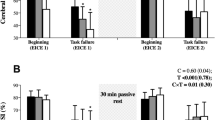Abstract
While there is some controversy whether anaerobic capacity might be improved after altitude training little is known about changes in anaerobic capacity during hypoxic exposure in highly trained athletes. In order to analyze the effects of acute moderate normobaric hypoxia on anaerobic capacity, 18 male competitive triathletes, middle- and long-distance runners \((\dot{V}\hbox{O}_2{\rm max} \, 67.4 \pm 3.8\,\hbox{ml}\,\hbox{kg}\,\hbox{min}^{-1})\) performed 2 supra-\(\dot{V}\hbox{O}_2{\rm max}\) treadmill runs with the same speed, one in normoxia and one after 4 h exposure to normobaric hypoxia (FiO2 0.15), for estimation of their maximal accumulated oxygen deficit (MAOD) and measurement of peak capillary lactate and peak capillary ammonia concentration. MAOD was not significantly different in normoxia and in moderate hypoxia while time to exhaustion and accumulated O2 uptake were significantly (P < 0.001) reduced in hypoxia compared to normoxia by 28 and 45%, respectively. The reduction in time to exhaustion was significantly correlated to the decrement in accumulated O2 uptake (R = 0.730, P = 0.001). In hypoxia, there was a tendency for peak capillary lactate concentration to be decreased compared to normoxia (12.9 ± 2.1 vs. 13.8 ± 2.2 mmol l−1, P = 0.082); peak capillary ammonia concentration was significantly decreased in hypoxia (97 ± 52 vs. 121 ± 44 μmol l−1, P = 0.032). In conclusion, anaerobic capacity is not significantly changed during acute exposure to moderate hypoxia in endurance-trained athletes. The performance reduction during all-out exercise of short duration has to be attributed to the decrement in aerobic capacity.



Similar content being viewed by others
References
Balsom PD, Gaitanos GC, Ekblom B, Sjodin B (1994) Reduced oxygen availability during high intensity intermittent exercise impairs performance. Acta Physiol Scand 152:279–285
Brosnan M, Martin DT, Hahn AG, Gore CJ, Hawley JA (2000) Impaired interval exercise responses in elite female cyclists at moderate simulated altitude. J Appl Physiol 89:1819–1824
Dudley GA, Staron RS, Murray TF, Hagerman FC, Luginbuhl A (1983) Muscle fiber composition and blood ammonia levels after intense exercise in humans. J Appl Physiol 54:582–586
Friedmann B, Siebold R, Bärtsch P (1996) Comparison of anaerobic capacity determined by different methods in 400 m- and long distance runners. Dtsch Z Sportmed 47:379–390
Gore CJ, Hahn AG, Aughey RJ, Martin DT, Ashenden MJ, Clark SA, Garnham AP, Roberts AD, Slater GJ, McKenna MJ (2001) Live high:train low increases muscle buffer capacity and submaximal cycling efficiency. Acta Physiol Scand 173:275–286
Green S, Dawson B (1993) Measurement of anaerobic capacities in humans. Definitions, limitations and unsolved problems. Sports Med 15:312–327
Itoh H, Ohkuwa T (1990) Peak blood ammonia and lactate after submaximal, maximal and supramaximal exercise in sprinters and long-distance runners. Eur J Appl Physiol 60:271–276
Kato T, Matsumura Y, Tsukanaka A, Harada T, Kosaka M, Matsui N (2004) Effect of low oxygen inhalation on changes in blood pH, lactate, and ammonia due to exercise. Eur J Appl Physiol 91:296–302
Levine BD (2002) Intermittent hypoxic training: fact and fancy. High Alt Med Biol 3:177–193
Levine BD, Stray-Gundersen J (1997) Living high-training low: effect of moderate-altitude acclimatization with low-altitude training on performance. J Appl Physiol 83:102–112
Lowenstein JM (1990) The purine nucleotide cycle revisited [corrected]. Int J Sports Med 11:S37–S46
Mairbäurl H, Schobersberger W, Humpeler E, Hasibeder W, Fischer W, Raas E (1986) Beneficial effects of exercising at moderate altitude on red cell oxygen transport and on exercise performance. Pflügers Arch 406:594–599
McLellan TM, Kavanagh MF, Jacobs I (1990) The effect of hypoxia on performance during 30 s or 45 s of supramaximal exercise. Eur J Appl Physiol 60:155–161
Medb JI, Mohn AC, Tabata I, Bahr R, Vaage O, Sejersted OM (1988) Anaerobic capacity determined by maximal accumulated O2 deficit. J Appl Physiol 64:50–60
Meeuwsen T, Hendriksen IJM, Holewijin M (2001) Training-induced increases in sea-level performance are enhanced by acute intermittent hypobaric hypoxia. Eur J Appl Physiol 84:283–290
Mizuno M, Juel C, Bro-Rasmussen T, Mygind E, Schibye B, Rasmussen B, Saltin B (1990) Limb skeletal muscle adaptation in athletes after training at altitude. J Appl Physiol 68:496–502
Ogura Y, Katamoto S, Uchimaru J, Takahashi K, Naito H (2006) Effects of low and high levels of moderate hypoxia on anaerobic energy release during supramaximal cycle exercise. Eur J Appl Physiol 98:41–47
Ravier G, Dugue B, Grappe F, Rouillon JD (2006) Maximal Accumulated Oxygen Deficit and Blood Responses of Ammonia, Lactate and pH after Anaerobic Test: a Comparison between International and National Elite Karate Athletes. Int J Sports Med 27:810–817
Roberts AD, Clark SA, Townsend NE, Anderson ME, Gore CJ, Hahn AG (2003) Changes in performance, maximal oxygen uptake and maximal accumulated oxygen deficit after 5, 10 and 15 days of live high: train low exposure. Eur J Appl Physiol 88:390–395
Rusko HK, Tikkanen HO, Peltonen JE (2004) Altitude and endurance training. J Sports Sci 22:928–944
Saltin B, Kim CK, Terrados N, Larsen H, Svedenhag J, Rolf CJ (1995) Morphology, enzyme activities and buffer capacity in leg muscles of Kenyan and Scandinavian runners. Scand J Med Sci Sports 5:222–230
Svedenhag J, Saltin B, Johansson C, Kaijser L (1991) Aerobic and anaerobic exercise capacities of elite middle-distance runners after two weeks of training at moderate altitude. Scand J Med Sci Sports 1:205–214
Taylor AD, Bronks R (1996) Effect of acute normobaric hypoxia on quadriceps integrated electromyogram and blood metabolites during incremental exercise to exhaustion. Eur J Appl Physiol 73:121–129
Truijens MJ, Toussaint HM, Dow J, Levine BD (2003) Effect of high-intensity hypoxic training on sea-level swimming performances. J Appl Physiol 94:733–743
Weyand PG, Lee CS, Martinez-Ruiz R, Bundle MW, Bellizzi M J, Wright S (1999) High-speed running performance is largely unaffected by hypoxic reductions in aerobic power. J Appl Physiol 86:2059–2064
Acknowledgments
The study was supported by the Bundesinstitut für Sportwissenschaft, Bonn, Germany (VF 0408/01/01/2000-2001)
Author information
Authors and Affiliations
Corresponding author
Rights and permissions
About this article
Cite this article
Friedmann, B., Frese, F., Menold, E. et al. Effects of acute moderate hypoxia on anaerobic capacity in endurance-trained runners. Eur J Appl Physiol 101, 67–73 (2007). https://doi.org/10.1007/s00421-007-0473-0
Accepted:
Published:
Issue Date:
DOI: https://doi.org/10.1007/s00421-007-0473-0




